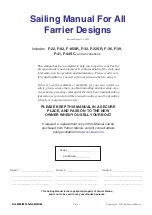
Copyright © 2012 By Farrier Marine Page 12
FARRIER MARINE
22, F-82, F-32, and F-36, can kick
back and is thus less likely to be
damaged in a grounding. However, it
should only be cleated in a cleat that
will let go at a certain load to avoid any
damage. A clam cleat with the teeth
filed slightly to reduce holding power
can be used for this. Never use a horn
cleat to hold the centerboard down.
When maneuvering in confined
waters
always have the board down.
This promotes quick turns, prevent-
ing any sideways motion. In general,
the board should always be down,
except perhaps when running down-
wind in light conditions. However, no
speed advantage has ever been found
for this, so probably easier to just
leave it down.
The board should always be half to fully down when
running or reaching in heavy winds or seas. It greatly
enhances directional control, keeping the tiller very light.
Should you at any time find the helm heavy, then
the causes could be the daggerboard being up, the
rudder has kicked back slightly (always watch for this),
or is not raked forward enough. Another possible
cause can be the mainsail sheeted in too tight (a
common fault). Even in the strongest winds, or the
fastest 20 knot spinnaker run, the helm should always
be light enough for easy one-handed control. If not,
you should check for reasons why.
RUDDER
Kick back rudders were used on all earlier designs, but
these do not work well in shallow water. Later designs
now have lift up daggerboard rudders, which are much
more effective. It is just a simple pull up or push down, and
depth/wetted area can be varied to suit the situation.
The daggerboard blade can also kick back in some
models, or is designed so that case aft end strip will shear
out in any grounding, so boat escapes any damage.
The earlier kick back rudders still work well and have
two control lines, one to pull up and one to pull down.
These should be color coded, with red (for danger) to pull
up, blue, for deep water, to pull down. The rudder will kick
back, should it hit bottom hard enough, the pull down line
pulling through the cleat.
At high speeds, the cleat alone may not be enough to
hold rudder down. In this case, a lock/shear pin can be
fitted through the case and blade as a positive lock down.
It is also a good idea to fit a horn cleat on the tiller as
a backup, but this should only be used if the hold down
cleat is worn, and the lock/shear pin is not available.
Never use the horn cleat where there is a danger of
grounding.
The rudder is held in the up position by the pull up line,
except with transom hung rudders, where the
pull down
line can actually work better once the rudder is lifted
vertically.
MAST SETUP
Rig tension and mast setup are very important for
good sailing performance and while rotating masts do not
require much rig tension (to allow full mast rotation), most
owners do not tension the fixed mast rigs enough. To
avoid this, a simple rig tension gauge (Loos Type recom-
mended) available at Marine stores can be purchased,
and this includes hints on tensioning your rig. Rigging
wire will stretch a little initially and all settings should be
checked after a few sails.
Rotating masts can use synthetic rigging, which will
stretch a little more, but this does not matter on a rotating
mast. Synthetic rigging is much lighter, easier on the
boat, easier to handle, and is now the recommended
choice.
Depending on type, synthetic rigging will stretch more
the first time out, sometimes considerably, so it needs to
be tightened up as you go. But once the initial stretching
phase is over it becomes very stable and only needs the
occasional check.
All masts should be set up with some prebend (center
of mast pushed forward). This will range from as little as
F-33 daggerboard rudder, with blade fully down
F-22 daggerboard rudder lifted partially up. The best solution for shallow water
Summary of Contents for F-22
Page 42: ......













































